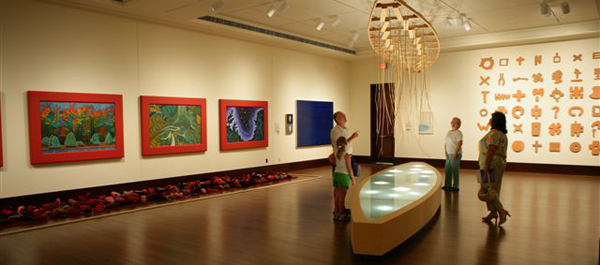
‘We have Cherokee artists, occasionally a Penobscot basket maker from Maine. We’ll have artists from the Pacific Northwest coast, and we’ve even had some Alaskan Inuits’
Indianapolis is perhaps best known for motorsports’ Indy 500. A major Midwestern metropolis more than 1,200 miles from Taos, N.M., it isn’t exactly a hotbed of Western history. So it might seem odd to find one of the world’s premier collections of American Indian and Western art here. Then again, one would probably find Harrison Eiteljorg an atypical art collector.
Sure, Eiteljorg’s mother was an artist, but her son didn’t head west until he was in his 40s, and then on coal-mining ventures. Eiteljorg, however, fell in love with the West and with Western art, especially the Taos Society of Artists. Even dearer to him was Indian art. Since 1989 his Eiteljorg Museum of American Indians and Western Art has enthralled and enlightened visitors (some 130,000 last year alone). It remains one of just two museums east of the Mississippi River dedicated to Indian and Western art, culture and history (Booth Western Art Museum in Cartersville, Ga., being the other).
“It really took my breath away,” museum CEO John Vanausdall recalls of his first visit to the Eiteljorg, soon after it opened. “You can’t help but walk in and feel that you’ve traveled somewhere. Our mission is to inspire an appreciation and an understanding of the art, history and culture. Those are different subject areas, but they do overlap. Within that we have a very aggressive contemporary art program.”
By the time of his death in 1997 Eiteljorg had amassed roughly 2,000 works of art. “Quite a collection,” Vanausdall affirms. Visitors will find traditional and contemporary pieces from such artists as N.C. Wyeth, Frederic Remington, Charles Russell, Georgia O’Keeffe, Andy Warhol, Allan Houser and Kay WalkingStick.
Collections include the Art of the American West Gallery of 19th- and 20th-century art, a showcase of the Taos masters. From 1915 to 1927 the Taos Society of Artists—founded by Joseph Sharp, Bert Phillips, Ernest Blumenschein, E.I. Couse, Oscar Berninghaus and Herbert “Buck” Dunton—was among the nation’s best-known art groups and helped spread appreciation for Southwestern art worldwide. “The entire collection is beautiful,” Vanausdall says, “but especially the Taos historical art. Eiteljorg was quite successful in acquiring many masterworks.” Other galleries hold the museum’s contemporary collection, its Native American collection and the Gund Collection of Western art, the latter assembled by the late businessman George Gund.
But the museum is much more than just an art lover’s mecca. The R.B. Annis Western Family Experience, for example, features hands-on activities to entertain and educate families. “Education is critical to what we do,” Vanausdall says. He points to the museum’s artist-in-residence program, through which a dozen artists teach classes and foster art appreciation among the broader Indianapolis community.
The weekend after Father’s Day the museum hosts its annual Indian Market & Festival, which draws some 140 artists from across North America and as many as 10,000 visitors. As Navajo painter Mark Silversmith of Durango, Colo., points out, most Indian art markets are held in the Southwest and draw artists primarily from Southwestern tribes, but the Eiteljorg’s event appeals to a broader spectrum of artists and aficionados.
“I think that is an advantage of our location,” Vanausdall says. “We have Cherokee artists, occasionally a Penobscot basket maker from Maine. We’ll have artists from the Pacific Northwest coast, and we’ve even had some Alaskan Inuits.”
“The Eiteljorg does a great job of promoting authentic Native American arts and crafts in the Midwest,” Silversmith adds.
Even the museum itself is a work of art. Designed by architect Jonathan Hess following travels across the Southwest with Eiteljorg, the Pueblo-influenced structure has become a highlight of downtown Indianapolis.
“It’s a unique feature on the landscape here,” Vanausdall agrees.
Visit the Eiteljorg Museum online.




